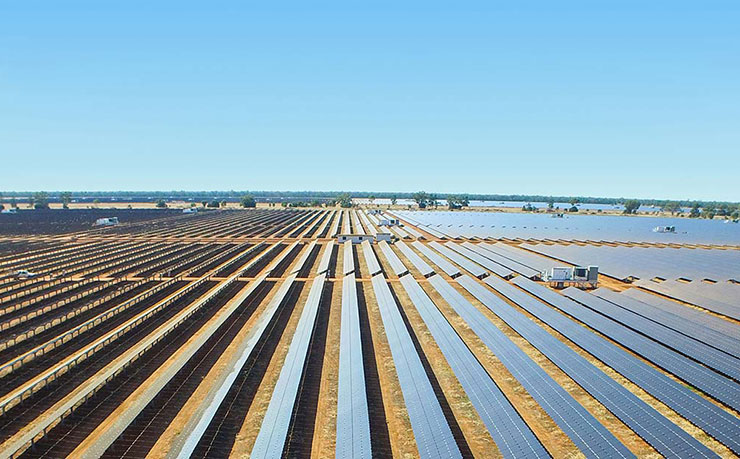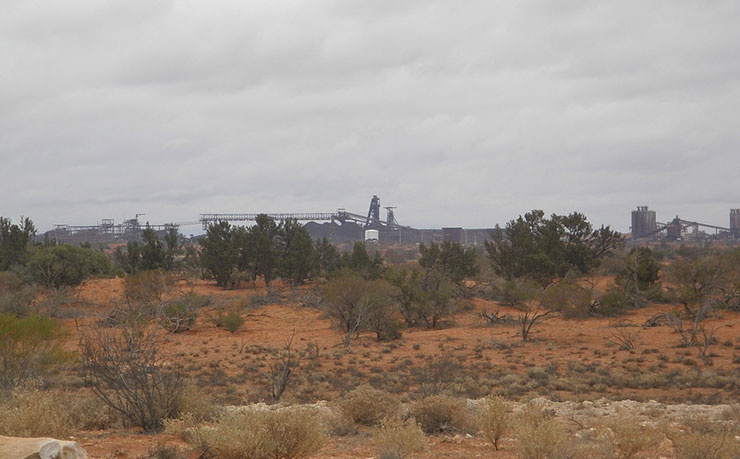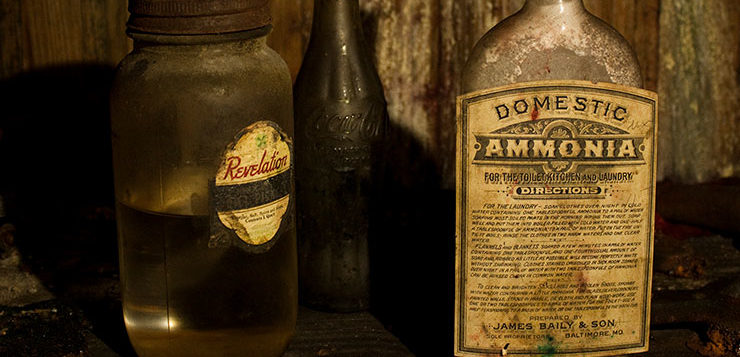DON’T MISS ANYTHING! ONE CLICK TO GET NEW MATILDA DELIVERED DIRECT TO YOUR INBOX, FREE!
The ‘next big thing’ in the environmental movement appears to be ammonia, or rather a more efficient way to make it. Geoff Russell crunches the numbers, and they’re not particularly encouraging.
During the recent election campaign, the “renewable energy super power” mantra got thrown around a bit by people desperate to believe that the election was about the global climate catastrophe, instead of being about self-interest and taxes. All told, it was a pretty confusing time.
How could coal miners vote Liberal? Realising that coal miners earn considerably more than scientists is a clue. It’s common for people who earn buckets of money to think that their income is also a measure of both their knowledge and intelligence. Lawyers, lucky entrepreneurs and even US Presidents can suffer the same delusions. Lawyers do tend to be smart, but that just makes their frequent scientific illiteracy and ignorance particularly dangerous.
But what about that mantra? It has such a great ring, “renewable energy super power”! What’s not to love. But why do they keep mentioning ammonia? What’s that about?
Here’s some background.
Big Ammonia
The world produced 200 million tonnes of ammonia last year; or more than three times more ammonia than cattle meat.
This might surprise you if you think of ammonia as some kind of old-fashioned cleaning product your grandmother used to use. But ammonia is at the heart of most fertilisers; so it’s at the start of any modern food chain, including the cattle meat food chain.
Many of Australia’s 77 million hectares of managed pastures will be fertilised with an ammonia-based fertiliser; particularly if used by dairy cattle.
How much land do you have to cover with solar panels to supply electricity to ammonia production lines to make 200 million tonnes of ammonia? That’s the multi-billion dollar question we’ll answer shortly.
Ammonia’s chemical formula is NH3. The N is for nitrogen. How do you measure the amount of protein in any food? Measure the nitrogen and multiply by 6.25 because nitrogen is about 16 percent of any protein.
During the manufacture of ammonia, the nitrogen is plucked from the air and bonded with hydrogen, this is mixed with other stuff to become fertiliser which is then used by plants to make protein; among other things.
Without that 200 million tonnes of fertiliser, our global protein supply would be seriously limited because very few plants can pull nitrogen from the air. Legumes can do it, using special bacteria bound to their roots. But other plants have to rely on getting it from the soil. And once it’s gone, you have to put it back. Hence the need for fertiliser. Alternatively, you can or plant some legumes and wait for them to work their magic.
So much for the N, but what about the H… the hydrogen?
At present, it comes almost entirely from fossil fuels, mostly coal and gas… they aren’t called hydrocarbons for nothing.
That 200 million tonnes of ammonia is produced in large factories and the production process generates about 400 million tonnes of carbon dioxide per year. So it’s a process that needs cleaning up.
Water is H2O, so why not get the hydrogen from water instead of coal and gas? Because water molecules are really tough to break apart; meaning that it takes a large amount of energy and typically only takes place at a high temperature and pressure. Note that boiling water achieves nothing… steam is still H2O, the molecules are entirely intact, just rather more widely separated.
The processes that produce ammonia using electricity and water typically take about 11 or so megawatt-hours of electricity to produce a tonne of ammonia. Some people reckon this is a terrific application for solar power. I’ll get to the CSIRO breakthrough shortly.

Nyngan is one of Australia’s largest solar plants; covering about 250 hectares and producing about 233 gigawatt-hours of energy annually; a gigawatt is a billion watts.
To make 200 million tonnes of ammonia annually using a bunch of Nyngan-like solar plants, you’d need to build 9,442 Nyngan solar farms covering 2.36 million hectares.
One down, 9,441 to go.
We can of course divide the job up and have 100 countries each building 94 Nyngans. That’s much more manageable and only gives us 93 more Nyngans to build; or another 23,500 hectares to cover in solar panels. Assuming everybody else pulls their weight and covers the rest of the 2.36 million hectares.
But there’s a catch. Did anybody else notice the IPBES report on Biodiversity and ecosystem services?
What was the number one cause of our loss of biodiversity and ecosystem services? Habitat loss and degradation. Think about 2.36 million hectares. Our intensive land use in Australia – our cities – cover about 1.4 million hectares. So 2.36 million is rather a lot… just to make fertiliser.
The CSIRO breakthrough in synthesising ammonia, assuming it can be scaled up, will require just 1.8 million hectares instead of 2.36. They are aiming at 8.5 megawatt-hours per tonne of ammonia rather than 11.
Replacing oil
But of course, the boffins working on ammonia aren’t just interested in ammonia and fertiliser, they have the entire global energy supply in their sights.
The plan is to make ammonia using renewable energy and ship it globally. That’s what the renewable energy super power chant is all about. You can then use the ammonia to power vehicles, either directly or by cracking the NH3 and extracting the hydrogen and using it in fuel cells.
Ammonia has well under half the energy density of oil. So you need to produce two tonnes of ammonia to replace one tonne of oil. The amount of land required to produce oil is tiny; because oil comes in 3D deposits. Oil flows out of holes in the ground and you can think about the power per square meter as the energy flowing from the wells in an area.
Energy expert Vaclav Smil did this kind of calculation and found that power from oil typically achieves rates between 125 and 40,000 watts per square metre (w/m2) of the size of the field. If we calculate the power per square metre (averaged over 24 hours) of Nyngan we get a figure of just over 10 (w/m2), and this drops to about 6 (w/m2) when we use the solar power to make ammonia using the new super-efficient CSIRO method.
Clearly wildlife habitat will take a hammering if this kind of technology really is scaled up to take on oil.
And what about Liquid Natural Gas?
Australia exports about 52 million tonnes of LNG annually. LNG is even more energy dense than oil, so to replace that 52 million tonnes with ammonia would require us to make about 150 million tonnes of the stuff; which we could do with about 5,500 Nyngan solar farms covering an area about the same as all our cities… about 1.4 million hectares.
I’ve mentioned the inefficiencies of making and shipping ammonia relative to oil and LNG, but they are compounded at the other end of the equation also; the cracking of NH3.
Asian Renewable Energy Hub
In northern Australia there is a massive project underway; the Asian Renewable Energy Hub (AREH). It’s been running since about 2014, when surveying began to find a suitable site in WA. This was followed up by wildlife surveys and negotiations to get the Traditional Owners on side.
The goal is to put 1,740 large wind turbines and about 25 Nyngans on 700,000 hectares of land and use it to make electricity and ammonia. Interestingly, while a July article in Science puts the price at US$10 billion, a press release a few months later puts the price at A$22 billion… an $8 billion Aussie dollar price jump in just 3 months! That has to be some kind of record. The press release talks about 47 terawatt-hours of electricity annually.
How big is 47 terawatt-hours? It’s about 20 percent of Australia’s annual electricity use. If all you used it for was ammonia production, it would make about 2.7 percent of the current global output.
Of course there is another source of energy we already export which contains more energy than our 52 million tonnes of LNG; uranium. The 7,679 tonnes we exported in 2016 contains more energy than the 52 million tonnes of LNG. But when you talk to Greens, as opposed to professional environmental scientists, they throw up their hands and say: “But what about the mining!!”.

Olympic Dam – the largest known single deposit of uranium in the world – is being expanded to provide more copper, with that increased demand being driven by the remarkable lack of efficiency that defines anything to do with renewable energy. Olympic Dam will go from 200,000 tonnes per year of copper to 350,000 tonnes.
Tell any environmentalist that renewables require about 7-10 times more mining than nuclear power and they look at you like you are crazy. Typically because they know zero about any kind of mining anyway.
How many Asian Renewable Energy hubs will it take to make enough ammonia to displace our 52 million tonnes of LNG? About 30.
Ammonia is one of about 20 major chemicals whose production uses significant amounts of energy. We have to clean up all of them; so we need the best possible source(s) of clean electricity and we need prodigious amounts.
One chemical deserving special mention is benzene. Global production is about 50 million tonnes annually. Amazing how often that number is coming up in this article!
Benzene is both carcinogenic and really toxic. A couple of teaspoons will kill you. Fifty million tonnes is enough benzene to kill everybody on the planet about half a million times over. If you are prone to worrying about radiation, I suggest you shift your concern to things which are far more dangerous; there is no shortage of contenders.
Benzene is just carbon and hydrogen; it gets used for making many things, including plastics. If you could make benzene and plastics with carbon pulled from the air and hydrogen pulled from water, then landfills could be rebranded as carbon sequestration repositories; in which case buying plastics and dumping it in landfills would then become a public service.
But whether that and other sequestration tricks are practical will depend crucially on access to plenty of eco-friendly clean energy.
Dual anti-science threats to the climate
The renewable energy superpower plans are only rational in a world where the safest and most eco-friendly energy source is left on the bench; nuclear power. Globally, renewable energy plans are even worse than just massive wind and solar farms. They represent an assault on nature second only to meat and dairy production. They include thousands of dams, and the harvesting of millions of hectares of forest.
Those wanting to prevent a climate catastrophe while minimising our appropriation of wildlife habitat are now fighting two large anti-science factions. The first and by far the biggest, are those who don’t believe we are warming the planet; the second would rather the planet burn than support nuclear power.
The two factions have plenty in common, the former hasn’t followed three decades of climate research but have firm opinions regardless, and the latter haven’t followed three decades of DNA repair, cancer and radiation science, but have firm opinions regardless.
Many in both factions believe in global conspiracies.
Many climate change deniers believe that scientists distort findings to garner funding rewards while anti-nuclear campaigners postulate a multi-decade coordinated cover up by the IAEA and World Health Organisation. Watch this clip starting at 11:45 to see one of the world’s great conspiracy theorists in full flight.
The predicted surge in overall cancer rates from the Chernobyl accident which anti-nuclear campaigners have been predicting for decades hasn’t eventuated; and oncologists know why. The predictions were based on 1950s science when nothing was known about DNA repair. The few actual cancers from Chernobyl have killed less people over the past 30 years than the 30 or so children under the age of 5 who drown in backyard swimming pools in Australia every year. And Ukraine’s overall cancer incidence rate is about half that of Australia.
The big causes of cancer weren’t known when Dr Helen Caldicott got her qualifications and they are all lifestyle related. Even quite large doses of radiation don’t cut it next to being overweight, inactive, drinking, smoking, and/or with a serious beef, pork and/or processed meat habit.
Even being tall confers a bigger risk for cancer than a large dose of radiation! Why? That’s fascinating and maybe I’ll write about it some time. But the anti-nuclear movement isn’t based upon knowledge, but fear. And their fears are like those of people afraid of flying; understandable in the light of decades of propaganda, but totally and utterly inconsistent with the evidence. That’s why they need the conspiracy theories.
In the absences of nuclear power, so-called environmentalists really do envisage covering millions of hectares of wildlife habitat in panels and turbines together with a vast increase in global mining and chemical production to cobble the whole Heath-Robinson mess together.
Some believe that getting a social licence for nuclear power will take a decade. But I think most of the hard work has been done. In 2014 BraveNewClimate published an open letter to environmentalists about nuclear energy. It’s a veritable who’s who of top ecological scientists.
The anti-nuclear movement needs to be seen for what it is, a science denialist throwback that belongs in the climate change denial, anti-vaxxer, anti-GM dust bin. Calling them nuclear power deniers is entirely appropriate.
But perhaps it’s not surprising that current environmental leadership isn’t ready to change. They are still in denial of the biodiversity impacts of animal agriculture. The IPBES summary report couldn’t have been clearer… the primary driver of our biodiversity crisis is habitat loss.
Did anybody notice the 77 million hectare figure on managed pastures? Our Greens are in favour of extensive animal agriculture, so what’s another 15 million hectares or so to roll out 30 or more Asian Renewable Energy Hubs?
It’s time our Greens became green; they don’t even have rational plant-based food policies, let alone energy policies.
Getting a social licence for nuclear power shouldn’t take a decade, but it will take courage and leadership at the top to face down ignorant anti-nuclear bullies with their half-truths, falsehoods and nutter conspiracy theories.
DON’T MISS ANYTHING! ONE CLICK TO GET NEW MATILDA DELIVERED DIRECT TO YOUR INBOX, FREE!
Donate To New Matilda
New Matilda is a small, independent media outlet. We survive through reader contributions, and never losing a lawsuit. If you got something from this article, giving something back helps us to continue speaking truth to power. Every little bit counts.




